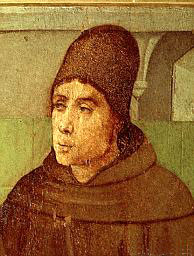
You might not know the guy in the picture above. John Duns Scotus, O.F.M, was one of the greatest theologians of the Middle Ages. A penetrating thinker of unsurpassed ingenuity, he was nicknamed the Subtle Doctor. Later on in this post, I’ll argue that in one particular respect, his philosophy is particularly ID-friendly – even more so than that of St. Thomas Aquinas. (By the way, my post on Aquinas, ID and evolution will be coming out next week.)
Duns Scotus, as he is generally known, appreciated arguments with many twists and turns, and I think he would have enjoyed reading Professor William Dembski’s recent post, Does ID presuppose a mechanistic view of nature? . But after reading his response to Dembski’s post, I get the strong impression that Professor Edward Feser does not appreciate subtle arguments. Fair enough. We all have our own personal strengths. Professor Feser is a formidable fighter, a brilliant metaphysician and a very profound thinker. If subtlety is not his cup of tea, then I shall undertake to rephrase Professor Dembski’s argument in a way that makes it crystal clear that ID’s argument for a Designer poses no threat whatever to Aristotelian and Thomistic arguments for the existence of God. By the way, this will be my last UD post in response to Professor Feser, as I think that prolonging the argument further would not be helpful. I shall do my best to make him reconsider his opposition to ID, in this post. Wish me luck!
All right. Now let’s get down to tin tacks.
What exactly does Professor Dembski mean by a “mechanistic” view of nature? Read More ›


